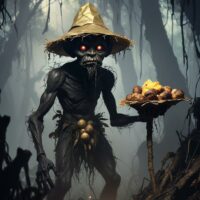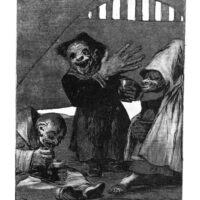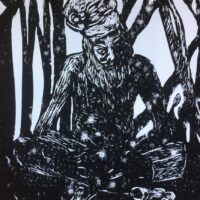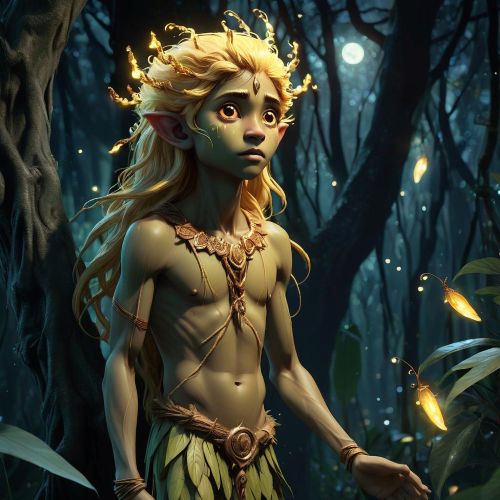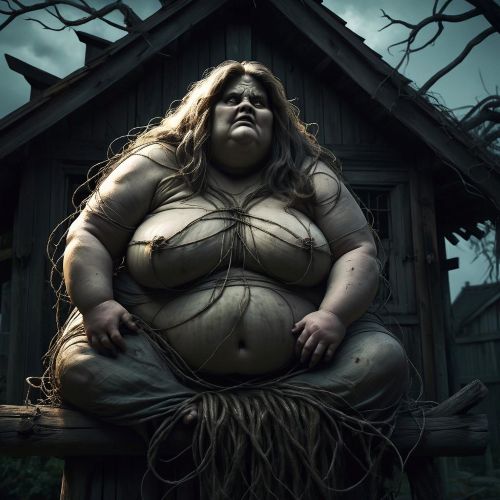Black Duwende – Bringer of Misfortune
Listen
At a glance
| Description | |
|---|---|
| Origin | Philippine Mythology |
| Classification | Spirits |
| Family Members | N/A |
| Region | Philippines |
| Associated With | Illness, Treasure, Bad Luck |
Black Duwende
Introduction
The Black Duwende, or Itim na Duwende, stands as one of the most ominous figures in Philippine folklore. Among the many spirit beings believed to dwell in the unseen world, duwende are some of the most culturally pervasive—tiny creatures tied to the land and often associated with luck, health, and fate. While white duwende are regarded as helpful or mischievously playful, the Black Duwende are notorious for their dangerous and vindictive nature. Found in rural myths, cautionary tales, and ghost stories, they are believed to bring about illness, confusion, and misfortune. These dark spirits command fear and respect, particularly in places where traditional beliefs and nature-centric spirituality remain strong.
Physical Traits
The appearance of the Black Duwende mirrors the malice attributed to them. They are small in stature, usually no taller than a handspan, but their features are exaggerated and grotesque. Their skin is described as pitch black, greasy, and textured like cracked leather, setting a visual tone of decay and darkness. Their eyes, glowing an eerie red or a dull orange, seem to pierce through shadows and human souls alike. Their pointed ears and misshapen noses are often likened to animals, especially rodents or bats. Adding to their otherworldly image, some accounts describe insect-like wings or twisted limbs, further emphasizing their alien and threatening presence. An acrid, rotting stench is often associated with their arrival, and many stories include a chilling silence that descends before they appear.
Family
Though duwende are generally seen as communal beings, the Black Duwende are often portrayed as solitary or aligned with darker spirits. Unlike the familial harmony among white duwende tribes, black duwende are more reclusive and frequently portrayed as vengeful loners or outcasts. They may form loosely bonded groups, but their relationships are dominated by hierarchy and fear rather than cooperation. These entities are particularly sensitive to disrespect and have been blamed for taking vengeance not only on individuals but on entire households. When insulted—whether by unintentional trespassing on their mounds or by disrupting their sacred spaces—they are believed to cast long-standing curses on families, targeting the vulnerable members such as children and the elderly. This intergenerational affliction links their myth to broader themes of familial duty and ancestral respect.
Other names
Although commonly called Black Duwende in Tagalog-speaking regions, these beings go by different names across the archipelago. In Pangasinan, a similar spirit is known as Ugaw, a mischievous figure that invades granaries and causes bad luck. Other regional terms include Nuno sa Punso, meaning “old man of the mound,” which is sometimes used interchangeably with duwende. In the highlands of the Cordilleras, particularly among the Ifugao, the term Kutong-lupa, or “earth lice,” is used to describe malevolent subterranean spirits. While these names may carry different nuances, they share a core belief in earth-dwelling entities whose wrath can be provoked by disrespect or carelessness. Some scholars trace these beliefs to pre-colonial animistic practices, further enriched by Spanish and Catholic influences during colonization, leading to a complex spiritual taxonomy for these creatures.
Powers and Abilities
The fear surrounding Black Duwende is largely due to their supernatural capabilities. They are said to wield dark magic that causes unexplainable physical ailments, including persistent rashes, high fevers, and swelling—conditions that resist typical medical treatment and respond only to rituals or spiritual intervention. Their magic can also influence luck, relationships, and mental well-being. In folklore, they are portrayed as tricksters who steal belongings, create illusions, and hide inanimate objects, turning homes into spaces of confusion and fear.
One of their more feared abilities is the power to curse or kidnap. Victims of these kidnappings are often said to vanish without a trace, reappearing later dazed, sick, or changed in personality. In some stories, kidnapped individuals become servants in the duwende’s underground realm, only returning if the correct ritual is performed. The Black Duwende are also believed to manipulate the natural world—causing crops to fail, rain to pour endlessly, or animals to fall ill. Unlike white duwende who may grant blessings, black duwende may offer cursed rewards, such as gold that turns to stone or wishes that twist into nightmares. Their magic thrives on imbalance and discontent, making them the embodiment of karmic retribution in the spiritual world.
Modern Day Influence
Despite rapid modernization, belief in the Black Duwende persists across many Filipino communities. In rural areas, people still utter “tabi-tabi po” when passing near mounds or wooded areas—a respectful phrase asking unseen spirits to step aside and avoid conflict. These traditions, while often treated with humor in urban settings, retain serious cultural significance in farming communities and provinces, where oral history and ancestral wisdom continue to guide everyday practices.
Contemporary media has also embraced the myth of the Black Duwende. In popular TV shows and comic series like Trese, these beings are reimagined as participants in the supernatural underworld of Manila. Here, the Black Duwende often play the roles of villains or shadowy power brokers, bringing ancient fears into modern narratives. Horror films frequently draw on duwende myths, using them as metaphors for psychological trauma, family curses, and colonial memory. These adaptations help maintain the relevance of traditional myths in the digital age.
In educational contexts, the Black Duwende is sometimes explored in classrooms and academic work as part of studies on Filipino mythology, animism, and pre-colonial spirituality. Artists and designers draw upon their eerie appearance for inspiration, creating visual art, cosplay, and game characters that reinterpret the folklore for global audiences. While they may no longer be feared as they once were, Black Duwende remain culturally potent figures—symbols of consequences, respect for nature, and the power of belief.
Related Images
Source
De Guzman, D. (2019). Duwende Lore in the Philippines. The Aswang Project. Retrieved from https://www.aswangproject.com/duwende-lore/
Ramos, M. D. (1990). Creatures of Philippine Lower Mythology. Phoenix Publishing House.
Licauco, J. T. (1990). Dwarves and Other Nature Spirits: Their Importance to Man.
Tan, B., Baldisimo, K., Hontiveros, D., Guerrero, B., & Malonzo, M. (2016). The Lost Journal of Alejandro Pardo: Creatures and Beasts of Philippine Folklore. Summit Books.
Ablir, R. (2024). The Enigmatic Dwende: Benevolent Guardians or Mischievous Tricksters?. PinoyMyths.com. Retrieved from https://www.pinoymyths.com/dwende-mythology/
Sinclair, J. (2024). Duwende: The Naughty Dwarves of the Philippines. Midnight Archives. Retrieved from https://www.midnightarchives.org/duwende-philippines/
Gaverza, J. K. (2024). Halimaween! Spirits That Rule the Night. Positively Filipino. Retrieved from https://www.positivelyfilipino.com/magazine/halimaween-spirits-that-rule-the-night
Cervantes, C. L. (2023). Urban Legends as Modern Folklore. The Aswang Project. Retrieved from https://www.aswangproject.com/urban-legends-philippines/
Trese Wiki. (n.d.). Amang Paso. Retrieved from https://trese.fandom.com/wiki/Amang_Paso
Frequently Asked Questions
What is lorem Ipsum?
I am text block. Click edit button to change this text. Lorem ipsum dolor sit amet, consectetur adipiscing elit. Ut elit tellus, luctus nec ullamcorper mattis, pulvinar dapibus leo.
What is lorem Ipsum?
I am text block. Click edit button to change this text. Lorem ipsum dolor sit amet, consectetur adipiscing elit. Ut elit tellus, luctus nec ullamcorper mattis, pulvinar dapibus leo.
What is lorem Ipsum?
I am text block. Click edit button to change this text. Lorem ipsum dolor sit amet, consectetur adipiscing elit. Ut elit tellus, luctus nec ullamcorper mattis, pulvinar dapibus leo.
What is lorem Ipsum?
I am text block. Click edit button to change this text. Lorem ipsum dolor sit amet, consectetur adipiscing elit. Ut elit tellus, luctus nec ullamcorper mattis, pulvinar dapibus leo.
What is lorem Ipsum?
I am text block. Click edit button to change this text. Lorem ipsum dolor sit amet, consectetur adipiscing elit. Ut elit tellus, luctus nec ullamcorper mattis, pulvinar dapibus leo.


